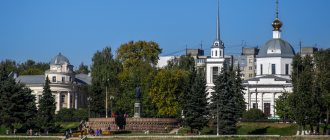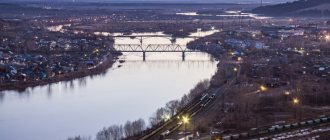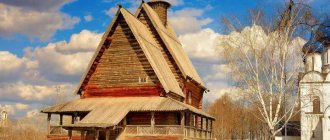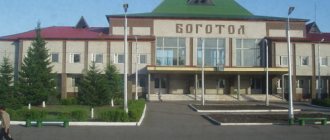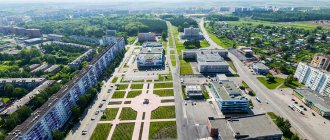Priozersk is a city in the north of the Leningrad region. I have been here many times while passing through on my way to Karelia. Being sure that apart from the fortress, which I visited back in 2010, there was nothing else to see in Priozersk, I always passed through it without stopping - well, except to stop at a gas station and buy all sorts of small things at local grocery stores. I remember that I once asked an acquaintance who lived here to show me the city - so he took me to some industrial zone located on the very outskirts, where he said that there was nothing else interesting in Priozersk. This time, while part of our team went to explore the fortress, which they had never been to before, I finally managed to look around a little. Previously, it seemed to me that Priozersk was completely rebuilt after the Second World War, and these days it should be an ordinary faceless Soviet regional center, built up with standard five-story buildings. But no! Some pre-war Finnish buildings, including wooden ones, have been quite preserved here. Come on, I'll show you!
One of the ancient legends says that Prince Rurik died on the site of present-day Priozersk in 879 (according to another legend, his grave is Shum Mountain in the Novgorod region).
There is no reliable written evidence about the time when the first settlement appeared on the shore of Lake Vuoksa (in ancient times it was known as Uzerva). Archaeologists believe that this happened no later than the 12th century. It is known that in 1295 a certain fortified point, located at the mouth of the Vuoksa, was plundered by Swedish knights who came here from the newly founded Vyborg.
The fortress that appeared here in the 13th century was traditionally called Korela in Russian chronicles. At that time, the fortification was the administrative center of the Korelia land, the prototype of modern Karelia. The Swedes called Korela Kexholm (from the Swedish Kexholm - “Cuckoo Island”), and from 1611 to 1918 the city was known by this name. In 1918, Finland, which gained independence, of which it was a part, renamed it in its own way - Käkisalmi (from Finnish Käkisalmi - “Cuckoo Strait”). Since 1948, the city received its modern name - Priozersk.
The main city attraction is the Korela fortress. In the Middle Ages, this fortification was the most northwestern outpost of Rus'. Today, the fortress has been restored, and a historical museum is located on its territory.
This is what Korela looks like from a bird’s eye view (thanks to Anna Toporkova for the photo from a quadcopter). The endless blue in the background is Lake Ladoga.
View in the other direction - towards Lake Vuoksa. Before the appearance of the Losevskaya channel in the middle of the 19th century, the water level here was one and a half meters higher, and Korela was surrounded by water on all sides.
The central square of Priozersk is expectedly named after Lenin (in the past - Kauppatori, from Finnish Kauppatori - “Market Square”).
Old Finnish buildings have been partially preserved in the city center. For example, this building was built shortly before the Winter War in 1939. It was called “seurahuone”, a word that used to be used in Finland to designate multifunctional public buildings.
The distinctive house with a red tiled roof is a former Scandinavian bank built in 1925. Now this building houses the St. Petersburg Bank. We tried to get inside to photograph the tiled stoves preserved there, but were ingloriously kicked out by bank tellers. Well, nothing is sacred!
Next to the bank is another old Finnish building.
In 1930, a stone church was built in the city.
Next to it is the Spartak city court. Yes, yes, they play gorodki here.
An espalanda, a traditional city park for Finnish cities, stretches from the central square to the northeast, bounded by streets on both sides. In Priozersk these are Lenin and Kalinin streets (oh, those Soviet toponyms).
In the middle of the park stands one of the most unexpected monuments - the sculpture “Panther Bagheera and Mowgli”, which appeared here in Soviet times.
A couple of blocks from the central square, the old wooden buildings are partially preserved. By the way, these days it is unexpectedly in pretty good condition.
A local masterpiece of wooden architecture is the city railway station.
This building was built in 1916.
For some reason, the station waiting room is disfigured by a wretched plastic entrance. I can’t wait until we introduce fines for damaging old wooden buildings with cheap plastic double-glazed windows and other foreign elements.
That's all about Priozersk.
Sights of Priozersk on the map
Priozersk is a quiet provincial town 150 km from St. Petersburg, which has a rich 700-year history , during which it repeatedly passed from one state to another and changed its name. Korela, Kexholm, Käkisalmi, Priozersk - these are all toponyms of the same place, by which one can almost accurately determine who owned the city in different eras. Numerous historical vicissitudes have left amazing architectural monuments and religious buildings from the period of Russian, Swedish and Finnish domination over this territory. And if you add the fantastically beautiful nature of the Karelian Peninsula, it becomes clear why hundreds of thousands of tourists strive to see with their own eyes and spend several days in this original city.
The first written mention of Priozersk dates back to 1295 , when a well-fortified settlement was reported on the banks of the Uzerve (Vuokse) River. In Russian chronicles it was mentioned under the name Korela, but in Scandinavian (mainly Swedish) under the toponym Kexholm. The Chronicle reported the plunder of the settlement by the Swedish leader Suigurda Lokke and the almost lightning-fast response of the Novgorod Republic, which recaptured the settlement in the same year. According to the latest archaeological excavations, the first settlements of the Korel tribe in this place were already in the middle of the 12th century.
The importance of the city of Korela for Novgorod was quite great, because already in 1310 a capital fortress was erected to replace the one that the Swedish knights managed to take by storm. A siding route “from the Varangians to the Greeks” passed through the city , and along the Vuoksa River it was possible to get in the most convenient way to the Gulf of Finland and the coast of Finland. This determined for many years to come the fate of Korela as a strategically important place, for which there would be a struggle for centuries between Sweden and Novgorod, and later the Russian centralized state. At the time of the inclusion of the Novgorod lands into the Moscow Principality, the city on Uzerva already had 406 courtyards of townspeople, one church and 4 monasteries.
In the fall of 1580, Korely was taken by Swedish troops - modern artillery left no chance for the defenders behind the wooden fortress walls. However, already in 1595, after the next Russian-Swedish war, it was returned to Russia, but in 1610 it was ceded by Vasily Shuisky to the Swedish crown in exchange for military assistance against the Polish intervention . Thus began the hundred-year Swedish period in the history of the city, which was already called Kexholm.
In 1710, Kexholm was taken by Russian troops during the Northern War , and under the terms of the Nystad Peace Treaty it was finally returned to the Russian Empire, becoming the center of the Kexholm province of the Vyborg province. Since the 18th century, the importance of the city in military terms gradually declined, and the fortress was converted into a prison. Kexholm finally lost its strategic importance in 1811 after the annexation of the Grand Duchy of Finland to the Russian Empire. The city was transferred to the principality and remained there until the collapse of the country and the Finns gained sovereignty in 1917. During this time, the development of industrial production began in it, and there was also a decrease in the role of the traditional trade of local residents - fishing.
During the short period of being part of independent Finland, Kexholm acquired a new name “Käkisalmi”, the largest sulphate-cellulose plant in Europe , and one of the most recognizable landmarks of the city - the Lutheran Church designed by the architect Armas Lindgren. As a result of the Soviet-Finnish and Great Patriotic War, the city was returned to the USSR and received its modern name - Priozersk. Now the city is a quiet provincial place with great tourism potential, which can be successfully revealed as part of the “Silver Necklace of Russia” route.
How to get to Priozersk
You can get to Priozersk by several means of transport:
- by car: from St. Petersburg on the A129 highway it takes about 2 hours;
- by train or commuter train: the journey from Finlyandsky Station in St. Petersburg takes about 3 hours;
- by bus No. 859 or 960 from St. Petersburg: the ride takes about 3 hours.
The most convenient trains are:
- St. Petersburg - Kuznechnoye (express);
- St. Petersburg - Kostomuksha (long-distance train).
The most convenient, but most expensive way is a taxi. You can get to Priozersk on it from almost any city; in this case, the fare is calculated either by travel time or by mileage. I had to get to different cities by taxi, sometimes due to a lack of tickets (for example, I went from Penza to Samara for the New Year holidays). All the offices where I inquired about the cost of travel politely offered to pay for the carrier’s services in advance. Moreover, the cost is calculated for the taxi driver’s round trip.
Lutheran Church
One of the most recognizable sights of Priozersk is the former Lutheran church, built in 1930 according to the design of the Finnish architect Armas Lindgren . This was not the first Lutheran church in the city - the penultimate building was erected in 1759, but it could not accommodate everyone and by the second decade of the 20th century it had become very dilapidated. The new building, which has survived to this day, was built practically by “the whole world” - donations from townspeople, the Savo Jaeger Regiment stationed in Käkisalmi, government loans, as well as investments from several large banks in Finland. The new building of the Lutheran church was made in the style of Finnish romanticism with external decoration made of red granite brought from Ladoga . In 1937, a 36-register organ , and Godenhyelmin’s altar painting “The Crucifixion” was moved from the old church building.
In addition, the room was equipped with a heating system, which made it possible to use it for its intended purpose all year round. The fate of the new Lutheran church turned out to be sad. In 1940, the building was severely damaged as a result of Soviet aircraft bombing. After Kyakisalmi (Priozersk) transferred to Soviet jurisdiction, the premises were used for the needs of the NKVD. The events of the Great Patriotic War in the first half favored the Finns, and they were able to return the city to their fold, restoring the church by 1944. But according to the peace treaty signed in Moscow, Finland ceded Käkisalmi (Priozersk) to the Soviet Union. The religious building was closed and transferred to the needs of the local party branch. Later a House of Culture was opened there. In the mid-2000s, the building began to be put in order with the help of Finnish restorers. Currently, it hosts exhibitions of decorative and applied arts.
Address : Leningradskaya, 12, Priozersk, Leningrad region, 188760
What to see when traveling as a child
A tourist with a child can visit any attraction in Priozersk. The unique architecture and unusual nature will not leave your child indifferent. But if your child wants children's entertainment, visit the following places:
- monument "Mowgli and Bagheera";
- sculpture to the characters of “Thumbelina”;
- recreation park on Kamenisty Island.
Monument "Mowgli and Bagheera"
“Mowgli and Bagheera” is a sculpture dedicated to the heroes of R. Kipling’s book. This monument is more than 50 years old, and its author was the sculptor B. Karagod, who immediately after finishing his studies came to Priozersk for an internship. The monument represents the figure of Mowgli sitting next to Bagheera. The sculpture is installed on a low stone pedestal, to which steps lead, so this place is very popular with children. Kids sit on the panther figure and hug it while parents are busy taking photos.
At one time, this sculpture was the first monument in Russia to an Indian boy who grew up in the Jungle. Later, similar objects began to appear in other cities.
The monument to “Mowgli and Bagheera” is very popular among children.
The monument to the heroes of “The Jungle Book” is located in Petrovsky Square.
Sculpture of a toad from “Thumbelina”
The figure of a giant toad from the fairy tale about Thumbelina is installed not far from the Mowgli sculpture. A large green toad sits on a stone slab, and next to it in a large flower stands Thumbelina herself. The monument is cared for and, if necessary, restored, but in 2001, vandals destroyed part of the sculpture. For 13 years, the pedestal was decorated with a lonely toad; in 2014, a new figure was installed instead of the old Thumbelina.
Alas, the monument to the heroes from the fairy tale “Thumbelina” often suffers from vandals
Recreation park on Kamenisty Island
Recreation Park on Kamenisty is an amazingly beautiful forested park area on a separate island. This island is also called Rocky Island (Kalliosaari - “rocky island”). Like most attractions in Priozersk, Kamenisty has its own rich history. From the 17th to the 18th centuries there were defensive structures here, which have not survived to this day. In Soviet times, there was a mud bath on the island, where residents from different regions of the country came. Therapeutic mud was extracted from Lake Vuoksa. Currently, the island is a picturesque park with a rocky landscape.
I've been to rocky places. This nature, I must say, is amazing. If you forget for a while where you are, you can feel like a Viking. What is also surprising here is that in the summer heat it is cool in such places (the stones cool down during the night, and during the day they are cool). The main thing is to wear comfortable shoes: sneakers with thin soles can cause tired feet.
The park on Kamenisty Island offers fresh air, boulders, lots of water and centuries-old trees
You can get to the island on foot: you need to walk to Beregovaya Street, then cross the railway tracks and turn right. The park is located in the central part of the island.
Cathedral of the Nativity of the Blessed Virgin Mary
The Cathedral of the city of Priozersk is a unique temple that was not originally intended for believers of the Orthodox faith.
Over the almost century-long history of the city as part of the Kingdom of Sweden, there was not a single Orthodox parish in Priozersk (then called Kexholm), but a Lutheran church was erected in 1692. After the capture of Kexholm on September 8, 1710 by Russian troops under the leadership of Robert Bruce, the Lutheran church was converted into an Orthodox cathedral and illuminated in honor of the Nativity of the Blessed Virgin Mary - it was this holiday that the Orthodox celebrated on the day of the fall of the Swedish garrison of the fortress. Services in the former Lutheran church were held until 1836, when cracks appeared in the walls of the church and part of the bell tower collapsed. It was decided to build a new cathedral for the city in the Byzantine-Russian style and the Empire style that was dominant at that time. The main construction costs were compensated by the local merchant A.V. Lisitsyn (about 16,000 royal rubles), but the main architect was the French specialist Louis Tullius Johamm Visconsi . The illumination of the new cathedral took place in 1847.
During the years of Soviet power, the church was closed and until 1991 it was used as premises for various secular institutions. With the destruction of the USSR, the Cathedral of the Nativity of the Blessed Virgin Mary was returned to the Russian Orthodox Church. It remained practically undamaged over almost a century of use other than for its intended purpose - minor restoration work on the facade and interior decoration made it possible to quickly return it to its original appearance.
Address : st. Kalinina, 9, Priozersk, Leningrad region, 188760
What to see depending on the time of year
The sights of Priozersk delight tourists in all seasons. In summer it is green and romantic, in autumn and spring it is colorful, and in winter it is cool and magical. In addition, in different seasons Priozersk entertains its guests with events:
- Leningrad Region Day (July 28);
- sports and tourism festival “Ladoga Fest” (August);
- military-historical reconstruction festival “Kexholm Garrison” (September);
- ethnocultural festival of the Leningrad region.
Day of the Leningrad Region in the Priozersky District
Priozer residents respect the history of their region, so they actively take part in the regional holiday. On the region’s birthday, the Priozersk Philharmonic Society opens its doors to fans of official events, events are held on the streets and children’s playgrounds are open with games and competitions. During the celebration, you can not only take a walk and watch street concerts, but also learn more about the history of Priozersk and the region.
On the Day of the Leningrad Region, entire families and groups of citizens take to the streets
The celebration begins with a procession through the streets of the city, and the ceremonial part of the holiday takes place in the Philharmonic.
Sports and tourism festival "Ladoga Fest"
Ladoga Fest is a major international sports tourism festival. The authorities of the Leningrad region decided that Priozersk would be the birthplace of the new holiday (it will take place for the first time in 2022). The festival will last 9 days, and athletes from different cities and regions will take part in it.
Several competitions are planned as part of the festival:
- Priozersky Half Marathon (21.1 km);
- athletics mass race for the Cup of the head of the district administration (5 and 10 km);
- two-day King of the Hammers competition and off-road vehicle exhibition;
- sports auto tourism competitions and the “Tailwind” motorcycle festival;
- European gathering of off-road vehicle owners and enthusiasts;
- sports and tourism race Vuoksa Race and a large equestrian festival;
- ring trophy race on SUVs, buggies, ATVs and all-terrain vehicles;
- airsoft game and much more.
During the boat race, those interested will learn the basics of maritime and rigging, the history of shipbuilding, and the design of ships.
Those wishing to attend the festival as a guest or participant must be mobile. The holiday will begin in Priozersk and continue in various festival cities on the coast of Lake Ladoga. The last events will take place in the capital of the festival.
Military-historical reconstruction festival “Kexholm Garrison”
“Kexholm Garrison” is the only international reconstruction festival in Russia dedicated to the Peter the Great era. The first event was held in honor of the 300th anniversary of the liberation of the city in the Northern War. A reenactment is a historical event reenacted by historical actors with some degree of accuracy (the Swedish garrison held the siege for 2 months, but the reenactment of the assault lasts only 1 hour). Reenactors from several countries take part in the festival:
- Russia;
- Sweden;
- Finland;
- Baltic countries, etc.
Viewers can watch the recreated actions of soldiers of Peter the Great's Preobrazhensky Regiment:
- arrangement of the camp;
- drill demonstrations;
- preparing a soldier's lunch in the field;
- training for beginners;
- storming the Korela fortress;
- fighting at the fortress walls;
- surrender of the Swedish army, etc.
Photo gallery: scenes from the Kexholm Garrison reconstruction festival
The festival is dedicated to the 300th anniversary of the liberation of Kexholm in the Northern War, so the parties to the “battle” are Russian and Swedish troops
Actors from Moscow, St. Petersburg, Petrozavodsk, Vyborg, Riga, Narva and Sweden are participating in the reconstruction - all in costumes of the 18th century
A special bonus for the audience is the performance of the military orchestra of Peter the Great’s time
The main event of the festival is the capture of the Kexholm fortress by the troops of Peter I
Festival guests will be able to watch scenes from the life of the Kexholm garrison of the 18th century
The festival venue is the Korela fortress. The date may vary depending on the weather, weekends, etc. (usually the festival is held in the last ten days of September).
Annual ethnocultural festival “Russia - Consonance of Cultures”
“Russia - Consonance of Cultures” is a large-scale ethnocultural festival, which is held annually in different cities of the Leningrad region. This is a multinational holiday in which representatives of different regions of the Northwestern Federal District take part. Colorful festival events take place at several venues:
- festive procession of festival participants;
- interactive performances of nationalities;
- master classes on traditional crafts and national dishes;
- children's games and attractions;
- performances by creative groups.
Photo gallery: some sites of the festival “Russia - Consonance of Cultures”
Delegations from different districts of the region and national and cultural associations take part in the procession
The holiday is accompanied by a large concert with the participation of children's and adult creative groups
“National farmsteads” are exhibitions of traditional applied arts, household items, and national costumes
Each nationality of the region holds its own interactive platform with an exhibition and mini-fair
The festival hosts many master classes in which anyone can take part.
The location of the festival depends on which city acted as the organizer.
Train Station
One of the few log buildings that have survived in the city since Finnish times is the railway station building, built in 1916 according to the design of the architect Grönholma in the Nordic Art Nouveau style.
Initially it was a complex of buildings, including warehouses and a locomotive depot, but these buildings did not stand the test of time. In 1941, during the retreat, Soviet troops set fire to Kyakisalmi (Priozersk). But miraculously, the fire did not touch the station building, which over its 100-year history has undergone virtually no significant alterations, preserving for us the spirit of the era of the late Russian Empire and the last years of the Grand Duchy of Finland being part of a huge country. The only discrepancy is the color of the facade. In 2008 it was painted red, the standard color for Finnish stationmasters' houses.
Address : Privokzalnaya st., 1, Priozersk, Leningrad region, 188760
Tips for staying in Priozersk
Tourists should consider a few basic tips when preparing for their trip:
- if you are traveling to Priozersk by car, remember the speed limit: in some places the road looks like a mountain serpentine;
- In the evening it is cool near the reservoirs, so you need to take warm clothes with you;
- if you are going to visit wooded areas and parks, do not forget to wear closed clothing that will protect against ticks, mosquitoes and mosquitoes;
- take care of a spare mobile phone: a wet mobile phone is no help;
- Carry a sufficient amount of cash with you: taxi drivers and ferry drivers do not always accept cards;
- Prepare maps of the city, islands and entire region in advance: purchase a paper guide or download a special application.
Photo gallery: useful maps
A map of the islands is needed in order to navigate on the water
No trip is complete without a tourist card
A map of the area is needed for those traveling by car
Viking village Bjorkagard
Just 22 km from Priozersk - in the village of Berezovo - there are three living history museums:
- Streletsky fort
- Border Outpost
- Viking village Bjorkagard
The last location is the most famous and popular among tourists, and all thanks to the unusual concept of the exhibition. Firstly, all the exhibits here can and should be touched with your hands - they are reconstructions made in strict accordance with ancient technologies. Secondly, this is the unusual location of the Viking village - on Beloyarsky Island in the Lehmalahti Bay of Lake Ladoga. To get here, you need to take a boat and cross the small bay that separates the island from the mainland. Thirdly, the Björkagard Viking Living History Museum is a full-fledged village, where there is a traditional Scandinavian longhouse , ordinary Viking dwellings, a barn, storehouses and other outbuildings. The exhibition itself and all household items, weapons, and clothing date back to the era of the formation of the ancient Russian state and the invaluable role played by the Varangians in this process.
The “highlight” of the Viking village is full-fledged models of Varangian longships and other vessels. And in some of them you can swim through the waters of Lake Ladoga under the guidance of an experienced instructor.
Address : Beloyarsky Island, Berezovo, Leningrad region, 188751
Ladoga lake
At the end of the post there are a few photos of Lake Ladoga.
Still, it’s worth driving here, even if it’s on a bad dirt road, the scenery here is magnificent:
Church of St. Andrew the First-Called
Despite the fact that the temple was built quite recently - in 2000 - every year it is gaining popularity among guests of Priozersk and its outskirts. And it’s all about the unusual place chosen for the construction of the church - on a tiny rocky island on the Vuokse River . This is the only temple of its kind, which was even included in the Guinness Book of Records .
For a long time, it was possible to get to the Church of St. Andrew the First-Called only by boat in the summer, or on ice in the winter. But the tourist attractiveness of the object made it possible to create a more convenient demi-season path - a metal bridge with openwork railings. On the one hand, this, of course, destroyed the romantic appeal of the place, and, on the other hand, it added a new location for admiring the local landscapes and unique northern nature - right from the middle of the bridge.
Address : Vasilyevo, Priozersky district, Leningrad region, 188765
Road
The A-121 Sortavala highway leads from St. Petersburg to Priozersk and further to Sortavala. It is currently being actively reconstructed. Part of the road is a modern four-lane highway, two lanes in each direction, with a median, reflectors and lighting in certain areas.
Reconstructed highway A-121 “Sortavala”
Closer to Priozersk it ends and turns into an older two-lane road. Finally, beyond Priozersk to the border with Karelia there is a very winding dirt road (the asphalt has apparently been washed away). Next to it, construction of a new highway is underway at an accelerated pace, so that in a few years it will be possible to travel from St. Petersburg to Sortavala in a breeze.
Construction of the A-121 Sortavala highway near Berezovo (August 2018)
Other interesting places
For travelers without wheels, free walks around the city are ideal options. While walking, you can meet a lot of interesting things and visit places where guidebooks will never lead you. The city of Priozersk, whose attractions are open to tourists not only in the city center, but also on the outskirts, invites you to meet and explore the Museum of Local Lore, the monument to Peter the Great, the monument to Rurik, the monument to the defenders of the Karelian Isthmus, as well as the only monument to Mowgli on the territory of the Russian Federation. Tanks of the Great Patriotic War are installed in front of the main entrance to the Korela fortress. They were installed in honor of the 55th anniversary of the Victory of the Soviet people in World War II. The ISU-152 and the IS-3 tank are real combat vehicles that now guard the entrance to the park and the Old Fortress.
Metochion of the Valaam Monastery
On the territory of the old cemetery there is a courtyard of the Valaam Holy Transfiguration Monastery, created through the efforts of Patriarch Alexy II in 1990.
On its land there are two existing churches - the old Church of All Saints and the new Church of the Nativity of Christ. There are also several chapels here, in particular the chapel of St. Arseny. The monastery refectory is famous for its delicious pastries. Monks and workers live in the cell building and work on their own farm.
In the 90s on Vuoksi, the courtyard now has its own pier, from where pilgrims and necessary cargo are sent to the island of Valaam.
Dubki Park
The appearance of the park is closely connected with the founding date of the city; in September 1714, Peter the Great laid the first foundation stone of the residence and planted more than 200 oak trees. There were global plans for the development of the city, but after the death of Peter the Great, the “Oak Estate” fell into disrepair.
Today this is a favorite vacation spot not only for city residents, but also for guests of St. Petersburg. It offers beautiful views of Fort Toleben and the Gulf of Finland. In the park you can stroll along shady alleys and visit attractions. The park has an equestrian club, tennis courts, and numerous cafes. This is where public events and concerts are held, and in the winter there is an ice skating rink here. The main attraction of this place is the centuries-old oak tree.
Monrepos Park
Recommend a place
15
6
Mon Repos is a rocky landscape park on the shores of the Vyborg Bay. The name Mon Repos is translated from French as “my peace”, “my rest”.
The official name of the park is the State Historical-Architectural and Natural Museum-Reserve "Park Monrepos". This is the only rock landscape park of the 18th-19th centuries in Russia.
The total area of the museum-reserve is about 163 hectares. In 2010, Mon Repos Park turned 250 years old. In the 18th century, the owner of Mon Repos was the chief commandant of the Vyborg fortress P.A. Stupishin, then the Vyborg Governor-General Prince F. of Württemberg, and from 1788 to 1943 the Monrepos estate belonged to the family of barons Nikolai, with whose name the prosperity of this place is associated. It was Ludwig Heinrich Nikolai and his son Paul who created the park on the estate, which became so famous in Russia and Europe. The most famous architects, artists and sculptors of that time took part in the creation of Mon Repos.
The estate complex is a monument of classicism architecture from the early 19th century.
The museum was created here in 1988.
Interesting places to relax with children
Priozersk has specially equipped complexes for families with children: entertainment centers with slot machines, bathhouse complexes with children's pools, cinemas with a repertoire of children's cartoons, tourist centers with sports equipment for children from 3 years old.
Family Club "Ocean"
The leisure and recreation center includes a bath complex, a Finnish sauna, a phyto-barrel, and relaxation rooms for children.
In the “Ocean” there is a swimming pool with hydromassage, a specially equipped small pool with a slide and toys, balls, and armbands for children. The complex is located on Bumazhnikov Street 11.
Entertaining
The complex includes several recreation areas:
- Games on video simulators from 25 rubles.
- Interactive 7D attraction from 50 rub.
- Short 3D cartoons from 25 rub.
- Cafe with fresh pastries, a wide range of drinks and sweets.
The center is located on Zavodskaya str. 2.
Water adventures
Center for rental of boats, sports and tourist equipment. Cost from two hundred rubles. Providing consultation with a specialist, organizing water and hiking trips. Conducting tournaments, battles, relay races, water sports races. Located at: Beregovaya street 1
Where else to go and what to do?
In addition to the main attractions, Priozersk also boasts interesting leisure activities: here you can go fishing, relax in sanatoriums, and travel through the Karelian forests.
Gastro tours, including to Karelia, have become very popular. Read here about gastronomic tourism in Russia.
What to see in one day?
In 1 day in Priozersk and the surrounding area you can:
- visit the Korela fortress museum and examine all the exhibits and objects;
cross the Vuoksu wooden bridge at the place where the waters of the river connect with Lake Ladoga;
visit the Konevsky Monastery and the Horse-Stone on the island;
go to a fish smokehouse in Losevo.
Historical reconstructions and medieval festivals are often held in Priozersk. If you're lucky, you can get to one of these events.
What should a tourist do in winter?
Although Priozersk is geographically located in the Leningrad region, the winters here are snowy in Karelian style. Many tourists go to the city in winter to go skiing or sledding, roll around in the snow, celebrate the New Year and holiday holidays.
Thanks to the rocky terrain, alpine skiing is thriving in Priozersk - routes are laid here for beginners and lovers of active recreation.
In winter, fishing on the lake and rivers is popular. Many even compete to see who can catch the most.
Recreation centers
Recreation centers in Priozersk perform two functions at once - entertainment and health. People come here to improve their health, on vacation or on holidays.
Popular recreation centers:
- “Pearl” - located on the left bank of the Vuoksa, intended for business class representatives;
“Yunost” has affordable prices and is located in the village of Losevo. This is the only base in the Leningrad region where extreme sports enthusiasts can try their rafting skills;
“Dobry Los” is located in picturesque places and is conducive to a relaxing holiday. Nearby is a forest rich in mushrooms and berries, and a ski resort;
“Otradnoe” is a quiet and peaceful place, ideal for fishing. Suitable for middle class people.
You can see even more sights of Priozersk in this video:
This is interesting:
Subscribe to our interesting VKontakte group:
VKontakte Facebook Twitter Google+ Odnoklassniki My World
Where is Mount Elbrus located? Where is Sol-Iletsk located? Holidays in Chelyabinsk on the lakes: what could be more beautiful? Where to go in Kronstadt: photos and descriptions of attractions
Sablinskie caves
Recommend a place
18
2
Sablinsky caves are old underground workings where quartz sand was once mined for glass production. Now these artificial caves are visited with curiosity by tourists. In addition to them, in the surrounding area you can look at ancient burial mounds, visit the former estate of Count Alexei Tolstoy - the Pustynka farmstead, and see the place where Alexander Nevsky stayed with his army before going against the Swedes.
Sablinsky caves appeared at the end of the 19th – beginning of the 20th centuries. St. Petersburg needed a lot of glass; active construction was underway in the city. Natural reserves lasted until about the 40s of the last century. Abandoned caves began to gradually collapse
They still require caution during inspection. The labyrinths of underground mines are complex
Tourists are usually offered a tour of four large caves - Verevka, Shtany, Zhemchuzhnaya, Pomoika - and several small ones. These extreme places are located near St. Petersburg, in the Tosnensky district. You will have to travel 40 kilometers from the northern capital to explore the underground kingdom of Sablino.
Spaso-Preobrazhensky Monastery
The construction of the Spaso-Preobrazhensky Monastery began in the 14th century. The monks did not cut down a single tree; they only used those that had been knocked down by the wind. They barely had time to complete the construction and the number of monastic brethren increased to 600 inhabitants when Swedish troops began to penetrate here, and the monastery fell into disrepair.
Peter the Great did not particularly favor monasteries and monks, but he could not refuse the abbot of the Kirillo-Belozersky Monastery, who asked for the restoration of the Valaam monastery. And construction began again on the islands. And the tests continued: new wooden buildings were destroyed by fire
Elizaveta Petrovna paid special attention to the monastery, helped in its restoration, but what could the 11 monks who remained in the ruined monastery do, even with the support of the empress!
And yet the monastery rose. A new period of prosperity began in the 19th century, when Father Damascene ruled the monastery with a firm hand. He introduced a strict rule: a monk who came to Valaam could no longer leave it. Construction was carried out under the guidance of the best architects. It was then that a water supply system was built on Valaam, and regular communication with St. Petersburg was established. The monastery at this time had its own small fleet.
By the beginning of the 20th century, 1,000 people lived here. Russian sovereigns also came here as pilgrims: Alexander the First and Alexander the Second; Russian writers, artists and philosophers sought to gain wisdom here from the Valaam elders: Roerich, Shishkin, Kuindzhi, Leskov.
It was not easy for the monastery at a time when Valaam turned out to be Finnish territory. Russian Orthodox monastery in a Lutheran-Protestant country! It got to the point that services had to be conducted in Finnish. But every cloud has a silver lining. The involuntary “emigration” saved the monastery from ruin, but complete desolation awaited it ahead. Before the liberation of Valaam by the Soviet army, the monks, driven by fear of reprisals, left the island and subsequently founded a monastery in Finland, which they called New Valaam. And on the orphaned island, they first opened a school for young boys, and then a boarding house for the disabled.
Many years passed, and in 1989, on Valaam, on the significant day of memory of St. Andrew the First-Called, six monks landed on Valaam. A new life began for the old monastery.





